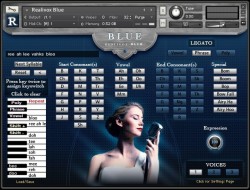 Realitone has released an update to its Realivox Blue vocal sample instrument.
Realitone has released an update to its Realivox Blue vocal sample instrument.
Realivox Blue is a vocal synthesizer that can translate words you type into vocals, and is based on 12,000 samples, carefully edited to allow individual sounds to be composited into words and phrases.
In the update, Realitone has improved the phrase builder of Realivox Blue by adding the ability to edit any syllable with Replace, Extend, Delete, Change Vowel, and Add Syllable options. Developers have also now added the ability to save and load whole banks of phrases.
RealiTone are also the developers of the whimsical RealiWhistle and RealiBanjo virtual instruments (because everyone needs a little “Yee-Haw!” sometimes).
Realivox Blue works in Kontakt or Kontakt Player, Mac & PC, VST, AU, RTAS, AAX. It’s available now for US $149, it is currently discounted to $129, or $139 for the Kontakt Player version.
More information is available on the RealiTone website.

OMG, that is genius, the only thing i cant do is ” play guitar & sing ”
play guitar – midi with native instrument
sing – THRU native instrument
thanks NI
This video is annoying!
I’ll sum this video up: “Hi we’re giving ourselves a pat on the back for almost fixing a user interaction model that should never have seen the light of day.”
That’s a text string. That’s one of the first things a computer programmer learns to parse. It is in no way amazing that they’ve allowed the editing and inserting of characters in a text field. This is a prime example of beautiful technology wrapped in bad software.
This is not just basic manipulation of text strings. Believe it or not, KSP (Kontakt’s scripting language) doesn’t allow editing of text strings in this context. (Text manipulation is a major weakness of KSP.)
All the editing you see happening actually involves a very complicated process of converting button pushes to numbers (arrays) and then to letters. The letters you see on the screen are never directly manipulated, because KSP has no idea that an “s” is an “s.” I know it sounds crazy, but there is literally no command to check if an “s” is an “s.” So these phrases may look like simple text strings, but they’re actually interacting sets of numerical arrays that store what GUI button got pushed to enter each “letter.” (There are actually 4 different s’s, by the way, depending on whether they’re before or after a vowel or consonant.) Heck, we even had to write a separate routine to determine the pixel length of each syllable as “letters” (actually just symbols in KSP) get added or subtracted.
Also, it’s important to understand that changing any letter or syllable isn’t just a simple matter of changing a few sounds. We recorded separate sets of samples for this library so that each consonant or vowel *interacts* with the consonants or vowels before and after it. (No other vocal sample library does that.) So in order to make it so you can edit in the middle of a phrase, we had rewrite how the samples arrays for the preceding and following syllables were determined.
Don’t get me wrong, if you don’t think the update or even the instrument itself is impressive, that’s fine. And I freely admit that I have been known to pat myself on the back from time to time. But this update was far from trivial to code.
It’s an remarkable post for all the internet users; they will obtain benefit from it I am sure.